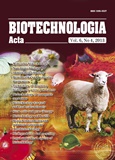ISSN 2410-7751 (Print)
ISSN 2410-776X (Online)

"Biotechnologia Acta" v. 6, no. 4, 2013
https://doi.org/10.15407/biotech6.04.078
Р. 78-85, Bibliography 33, Russian
Universal Decimal classification: 57.083.2+616.523
SEARCH OF INHIBITORS OF HERPES VIRAL REPLICATION: 30 YEARS AFTER ACYCLOVIR
Korovina A. N., Kuhanova M. K., Kochetkov S. N.
Engelhardt Institute of Molecular Biology of Russian Academy of Sciences, Moscow, Russia
Analysis of study and using of different chemical compounds as inhibitors of herpes virus replication is given in the review. However, it does not apply for full details of all the studies on active antiherpetic drugs finding. It’s been over 30 years since the discovery of the first antiherpetic drugs — acyclovir. Meanwhile, lots of active chemical compounds appeared that have been brought to the antiviral drugs. An essential understanding of strategies for finding drugs came in, one of which was establishment of depot forms of antiherpetic drugs. On the basis of the vast published experimental material the authors concluded that the study of the herpes virus and search for inhibitors of its replication is still an important issue and requires the efforts of chemists, biologists, pharmacists.
Key words: herpes virus, antiviral drugs acyclovir.
© Palladin Institute of Biochemistry of National Academy of Sciences of Ukraine, 2013
References
1. Coen D. M., Schaffer P. A. Nature reviews. Drug discovery. 2003, V. 2, P. 278–288.
https://doi.org/10.1038/nrd1065
2. Raab-Traub N. Current Opinion in Virology. 2012, V. 2, P. 453–458.
https://doi.org/10.1016/j.coviro.2012.07.001
3. Mesri E. A., Cesarman E., Boshoff C. Nature Rev. Cancer. 2010, V. 10, P. 707–719.
https://doi.org/10.1038/nrc2888
4. De Clercq E., Fiekd H. J. British J. Pharmacol. 2006, V. 147, P. 1–11.
https://doi.org/10.1038/sj.bjp.0706446
5. De Clercq E. J. Clin. Virol. 2001, V. 22, P. 73–89.
https://doi.org/10.1016/S1386-6532(01)00167-6
6. Bogani F., Boehmer P. E. Proc. Natl. Acad.?Sci. USA. 2008, V. 105, P. 11709–11714.
https://doi.org/10.1073/pnas.0806375105
7. Bogani F., Corredeira I., Fernandez V. J. Biol. Chem. 2010, V. 285, P. 27664-27672.
https://doi.org/10.1074/jbc.M110.131235
8. Liu S., Knafels J. D., Chang J. S. J. Biol. Chem. 2006, V. 281, P. 18193–18200.
https://doi.org/10.1074/jbc.M602414200
9. Terrell S. L., Coen D. M. J. Virol. 2012, V. 86, P. 11057–11065.
https://doi.org/10.1128/JVI.01034-12
10. Dorsky D., Crumpacker C. Antiviral research. 1987, V. 9, P. 92.
11. Elion G. B., Furman P. A., Fyfe J. A. Proc. Natl. Acad. Sci. USA. 1977, V. 74, P. 5716–5720.
https://doi.org/10.1073/pnas.74.12.5716
12. Schaeffer H. J., Beauchamp L., de Miranda P. Nature. 1978, V. 272, P. 583–585.
https://doi.org/10.1038/272583a0
13. Vadlapudi A. D., Vadlapatla R. K., Earla R. Pharm. Research. 2013.
14. Martin J. C., Dvorak C. A., Smee D. F. J. Med. Chem. 1983, V. 26, P. 759–761.
https://doi.org/10.1021/jm00359a023
15. Thust R., Tomicic M., Klocking R. Cancer gene therapy. 2000, V. 7, P. 107–117.
https://doi.org/10.1038/sj.cgt.7700106
16. Boyd M. R., Bacon T. H., Sutton D., Cole M. Antimicrobial agents and chemotherapy. 1987, V. 31, P. 1238–1242.
https://doi.org/10.1128/AAC.31.8.1238
17. Oberg B. Pharm. ther. 1989, V. 40, P. 213-285.
18. Helgstrand E., Eriksson B., Johansson N. G. Science. 1978, V. 201, P. 819–821.
https://doi.org/10.1126/science.210500
19. De Clercq E., Andrei G., Snoeck R. Nucleos., nucleot. nucl. acids. 2001, V. 20, P. 271–285.
20. Ivanov A. V., Andronova V. L., Galegov G. A., Jasko M. V. Bioorg. Chem. 2005, V. 31, P. 65–72.
21. Korovina A. N., Yasko M. V., Ivanov A. V. Vestnik Mosk. un-тa. Seriya 2. Khimiya. 2008, Т. 49, C. 108–111. (In Russian).
22. Karpenko I. L., Jasko M. V., Andronova V. L. Nucleos., nucleot. nucl. acids. 2003, V. 22, P. 319–328.
23. Skoblov Y. S., Karpenko I. L., Jasko M. V. Chem. Biol. Drug Des. 2007, V. 69, P. 429–434.
https://doi.org/10.1111/j.1747-0285.2007.00517.x
24. Gus’kova A. A., Skoblov M. Y., Korovina A. N. Chem. Biol. Drug Des. 2009, V. 74, P. 382–389.
https://doi.org/10.1111/j.1747-0285.2009.00874.x
25. Deev S. L., Yasko M. V., Karpenko I. L. Bioorg. Chem. 2010, V. 38, P. 265–270.
https://doi.org/10.1016/j.bioorg.2010.09.002
26. Gilbert C., Bestman-Smith J., Boivin G. Drug Resist Updat. 2002, V. 5, P. 88–114.
https://doi.org/10.1016/S1368-7646(02)00021-3
27. Korovina A. N., Gus’kova A. A., Skoblov M. Mol. biol. 2010, V. 44, P. 488–496.
https://doi.org/10.1134/S0026893310030118
28. Schnute M. E., Anderson D. J., Brideau R. J. Bioorg. Med. Chem. Lett. 2007, V. 17, P. 3349–3353.
https://doi.org/10.1016/j.bmcl.2007.03.102
29. Hwang Y. T., Smith J. F., Gao L., Hwang C. B. Virology. 1998, V. 246, P. 298–305.
https://doi.org/10.1006/viro.1998.9201
30. Suzutani T., Saijo M., Nagamine M. J. Clin. Microbiol. 2000, V. 38, P. 1839–1844.
31. Bestman-Smith J., Boivin G. J. Virol. 2003, V. 77, P. 7820–7829.
https://doi.org/10.1128/JVI.77.14.7820-7829.2003
32. Matthews J. T., Carroll R. D., Stevens J. T., Haffey M. L. J. Virol. 1989, V. 63, P. 4913–4918.
33. Matthews J. T., Terry B. J., Field A. K. Antivir. Res. 1993, V. 20, P. 89–114.
https://doi.org/10.1016/0166-3542(93)90001-Y

